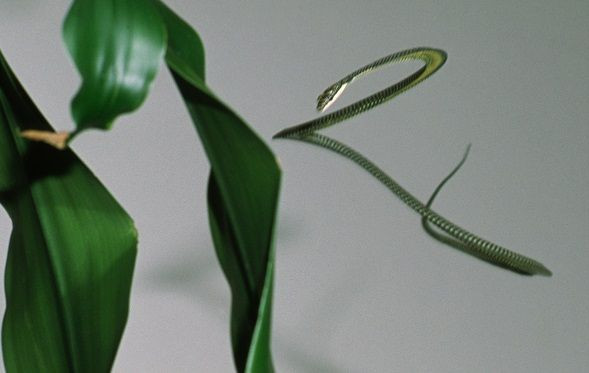Flying Snake Physics: Gliding Reptiles Use Their Curves To Get Lift

The secret to a flying snake’s ability to slither through the air is in its streamlined simplicity, researchers say.
In certain tropical forests of Asia, small snakes (not much wider than your thumb) in the genus Chrysopelea have mastered the art of gliding down from trees. And they’re pretty good at it too, with some species able to execute turns in mid-air. Virginia Tech engineer Jake Socha and colleagues were interested in investigating the physics of flying snake gliding, which they did with computer simulations to explore how the snake’s twists and turns affect the air around it, creating the forces that give it lift.
Their results, published on Tuesday in the journal Physics of Fluids, illustrate how the snake exploits its limbless body type.
“When it glides, [a flying snake] reconfigures its body to assume a flatter profile. During the glide, the snake undulates laterally and the parts of the body that are perpendicular to the direction of motion act as lift-generating ‘wings,’” Socha and colleagues wrote.
At certain angles of gliding, a snake’s curves can generate extra boosts of power.
Small vortices, or whirlwinds, of air “can give flying snakes an extra lift," coauthor Lorena Barba, an aerospace engineer at George Washington University, said in a statement. "The shape of the snakes in flight -- which is a flattened version of its shape at rest -- gets help from little vortices around it."
Understanding how flying snakes glide through the air could lead to new designs for miniature flying robots. In recent years, engineers have worked on modeling robots after bats, insects, and birds. Soon, there might be a new kind of glider in town, with a more sinuous shape.
"Rather than fixed wings, animal fliers have flapping wings,” Barba says. "In the case of gliders, their small scale means they're always in a flurry of whirling winds. By understanding how they can be graceful and efficient under these conditions, we can in turn use that knowledge to create small flying machines that are equally graceful."
But the study didn’t get a chance to model a whole snake body in its calculations – just a section of it. For their next stage of research, the team would like to run its simulations for the whole body of the snake.
"This will be more difficult to do in a computer model, but it will probably reveal more about the complicated flow patterns snakes take advantage of to be such gifted gliders," Barba says.
SOURCE: Krishnan et al. "Lift and wakes of flying snakes." Physics of Fluids published online 4 March 2014.
© Copyright IBTimes 2025. All rights reserved.





















